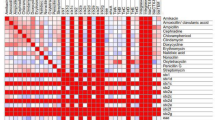Abstract
To examine the reason why people infected with Shiga toxin (Stx) producing Escherichia coli (STEC) O157 strains develop varying clinical manifestations, 65 STEC O157 isolates originating from 64 different occurrences of infection in Miyazaki Prefecture in 2001–2003 and their 79 infected individuals were analyzed by stx genotyping, quantitative analysis of reversed passive latex agglutination (RPLA), genomic DNA analysis using pulsed-field gel electrophoresis (PFGE), and clinical manifestations. The isolates were found to carry the following stx genes: stx2vha alone (60.0%), stx1/stx2 (27.7%), stx1/stx2vha (6.1%), stx2 alone (3.1%), and stx2/stx2vha (3.1%). No strain carried the stx1 gene alone. STEC strains carrying stx2 were more frequently associated with clinical manifestations of hemolytic-uremic syndrome (HUS) or bloody diarrhea than those carrying stx2vha. Clusters of PFGE banding patterns were correlated well with the stx genotypes. We conclude that stx genotype is one of the important factors of clinical outcome of STEC O157 infection and that pathogenicity for humans was higher in the stx2 genotype strains than in the stx2vha genotype strains, as reported previously by other researchers. Further, we newly found that four clusters identified by PFGE using restriction enzyme XbaI, stx genotypes and clinical manifestations were well correlated with each other.

Similar content being viewed by others
References
Calderwood SB, Acheson DWK, Keusch GT, Barrett TJ, Griffin PM, Strockbine NA, Swaminathan B, Kaper JB, Levine MM, Kaplan BS, Karch H, O’Brien AD, Obrig TG, Takeda Y, Tarr PI, Wachsmuth IK (1996) Proposed new nomenclature for SLT (VT) family. ASM News 62:118–119
Piérard D, Muyldermans G, Moriau L, Stevens D, Lauwers S (1998) Identification of new verocytotoxin type 2 variant B-subunit genes in human and animal Escherichia coli isolates. J Clin Microbiol 36:3317–3322
Schmidt H, Scheef J, Morabito S, Caprioli A, Wieler LH, Karch H (2000) A new Shiga toxin 2 variant (Stx2f) from Escherichia coli isolated from pigeons. Appl Environ Microbiol 66:1205–1208
Tyler SD, Johnson WM, Lior H, Wang G, Rozee KR (1991) Identification of verotoxin type 2 variant B subunit genes in Escherichia coli by the polymerase chain reaction and restriction fragment length polymorphism analysis. J Clin Microbiol 29:1339–1343
Eklund M, Leino K, Siitonen A (2002) Clinical Escherichia coli strains carrying stx genes: stx variants and stx-positive virulence profiles. J Clin Microbiol 40:4585–4593
Friedrich AW, Bielaszewska M, Zhang W-L, Pulz M, Kuczius T, Ammon A, Karch H (2002) Escherichia coli harboring Shiga toxin 2 gene variants: frequency and association with clinical symptoms. J Infect Dis 185:74–84
Scheutz F, Strockbine NA (2005) Escherichia. In: Garrity GM (eds) Bergey’s manual of systematic bacteriology. Springer Science + Business Media, Inc., New York, p607–624
Misawa N, Sueyoshi M, Uemura R, Kakemizu Y, Kawashima K, Nagatomo H, Kondo F, Murakami T, Takahashi Y (2000) Effect of bicozamycin on the eradication of Shiga toxin-producing Escherichia coli in calves. Microbiol Immunol 44:891–896
Karch H, Meyer T (1989) Single primer pair for amplifying segments of distinct Shiga-like-toxin genes by polymerase chain reaction. J Clin Microbiol 27:2751–2757
Nakao H, Kimura K, Murakami H, Maruyama T, Takeda T (2002) Subtyping of Shiga toxin 2 variants in human-derived Shiga toxin-producing Escherichia coli strains isolated in Japan. FEMS Immunol Med Microbiol 34:289–297
Matsumoto M, Suzuki Y, Nagano H, Yatsuyanagi J, Kurosawa H, Kobayashi K, Yamaoka K, Horikawa K, Kudaka J, Terajima J, Watanabe H, Miyazaki Y (2005) Evaluation of pulsed-field gel electrophoresis analysis performed at selected prefectural institutes of public health for use in PulseNet Japan. Jpn J Infect Dis 58:180–183
Karmali MA, Petric M, Bielaszewska M (1999) Evaluation of a microplate latex agglutination method (Verotox-F assay) for detecting and characterizing verotoxins (Shiga toxins) in Escherichia coli. J Clin Microbiol 37:396–399
Nishikawa Y, Zhou Z, Hase A, Ogasawara J, Cheasty T, Haruki K (2000) Relationship of genetic type of Shiga toxin to manifestation of bloody diarrhea due to enterohemorrhagic Escherichia coli serogroup O157 isolates in Osaka City, Japan. J Clin Microbiol 38:2440–2442
Paton AW, Srimanote P, Talbot UM, Wang H, Paton JC (2004) A new family of potent AB5 cytotoxins produced by Shiga toxigenic Escherichia coli. J Exp Med 200:35–46
Kulkarni H, Goldwater PN, Martin A, Bettelheim KA (2002) Escherichia coli ‘O’ group serological responses and clinical correlations in epidemic HUS patients. Comp Immunol Microbiol Infect Dis 25:249–268
Acknowledgement
We thank Dr. Amoako for critical reading of the manuscript and helpful comments.
Author information
Authors and Affiliations
Corresponding author
Rights and permissions
About this article
Cite this article
Kawano, K., Okada, M., Haga, T. et al. Relationship between pathogenicity for humans and stx genotype in Shiga toxin-producing Escherichia coli serotype O157. Eur J Clin Microbiol Infect Dis 27, 227–232 (2008). https://doi.org/10.1007/s10096-007-0420-3
Received:
Accepted:
Published:
Issue Date:
DOI: https://doi.org/10.1007/s10096-007-0420-3




